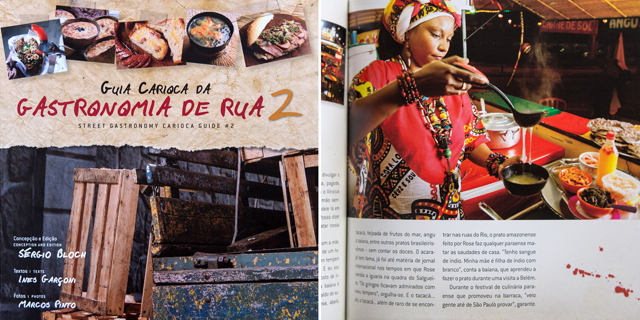Over the past two decades, Brazil and her carioca heart, Rio de Janeiro, have seen tremendous change. They tumbled from military dictatorship into economic collapse and then, recovering, strode on to become an economic powerhouse, set to host two of the world’s greatest sport spectacles in successive years. Through all this, as solid and dependable as the Pão de Açúcar, a small group of men and women have come out to the streets and beaches and served the hungry and the thirsty and in so doing, have themselves become part of the culinary history of Rio de Janeiro.
And Sérgio Bloch has managed to capture them all in his Guia Carioca da Gastronomia de Rua (Carioca Guide to Street Food). Now into its second edition, published at the end of 2012, this bilingual book is a treat for the growing legions of food-carters and street-eaters.
Bloch, a local director and writer, first started seeing the streets and the people on them in 1997 while filming a documentary short, Donkey Without a Tail, about the trash collectors of Rio. He went on to make two more documentaries about people, working, living, performing and trading on the streets, becoming fascinated by these very public figures with rich, though mostly unknown, stories so emblematic of modern Brazil.
It seems inevitable then that his growing love affair with the streets would combine with another passion, that of Brazilian food, and come together as this gorgeous book.
This edition is a compilation of the stories and dishes of 18 street chefs, some who have been in the same place, week after week for 30 years, as well known for their tasty treats as for the huge personalities. Each chef has several pages dedicated to them, their dish and the street, square, or beach where they work. Along with beautiful photographs by Marcos Pinto, these pages emanate the warmth of the city and the carioca good cheer that never seems to fade.
The guide opens with Luizinho’s caipirinhas, the finest in Larangeiras; his stall in Sao Salvador Square not only famous for drawing the thirsty, but also for the impromptu Samba jam sessions he hosts. We meet Luciano, the man with the best eye for coconuts in the city; Rose, the Bahiana who has mastered the famous northern dish, tacacá; Marquinho, who rides a two meter camel dragged along over the sands of Pepe Beach accompanied by belly dancers and music; Milton the Uruguayan from puesto 9 on Ipanema beach with his world-renowned sandwiches; and Aunt Marlene and her famous feijoada. And that’s only five of them. Each character is more colorful than the last, each dish more tempting.
With Brazilians finally beginning to look to their local cuisine as something to treasure, thanks to locals like Roberta Sudbrack or neighboring Paulistas like Alex Atala, Helena Rizzo, Rodrigo Oliveira, and Mara Salles, it is a great moment for a book like this. This is so much more than a ‘best of’ list; the stories told by the spices and stews are the stories of immigrants and locals who form the irrepressible foundation, the lifeblood of Rio de Janeiro.
(Be sure to check out their newly launched website, which, even though it is in Portuguese is easily navigable for foreigners and with the aid of a constantly updated map and a ‘what’s hot today’ list, will get you around to the best snacks on the streets of Rio.)


![Making Mealtime Matter with La Familia: Easy Sofrito [Video]](https://thelatinkitchen.com/wp-content/uploads/2015/10/sofrito-shutterstock__0-500x383.jpg)
![Easy Latin Smoothies: Goji Berry Smoothie [Video]](https://thelatinkitchen.com/wp-content/uploads/2015/12/goji_berry-shutterstock_-500x383.jpg)
















![Fun and Fast Recipes: Fiesta Cabbage Salad [Video]](https://thelatinkitchen.com/wp-content/uploads/2015/11/fiesta_cabbage_slaw-shutterstock_-500x383.jpg)









